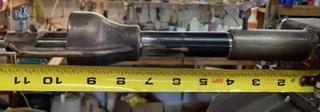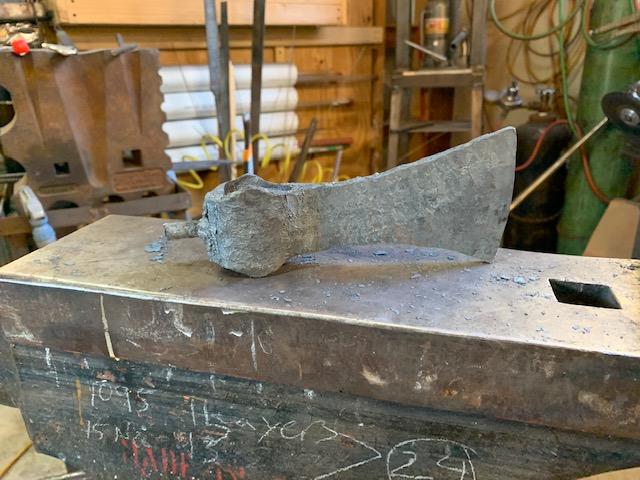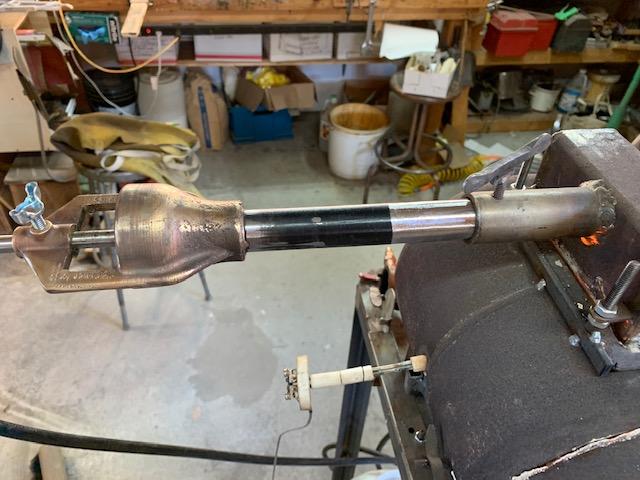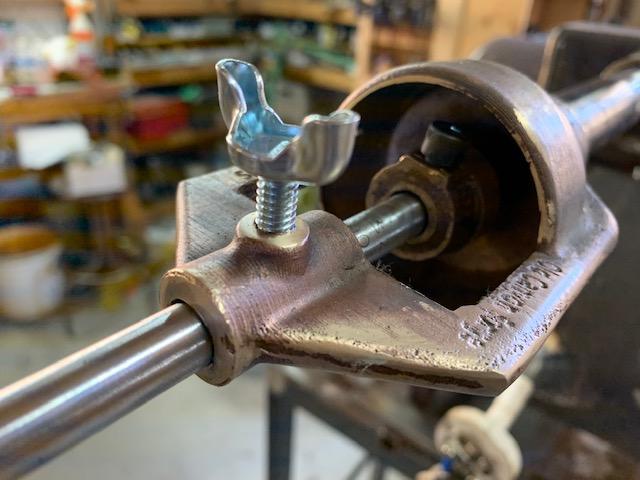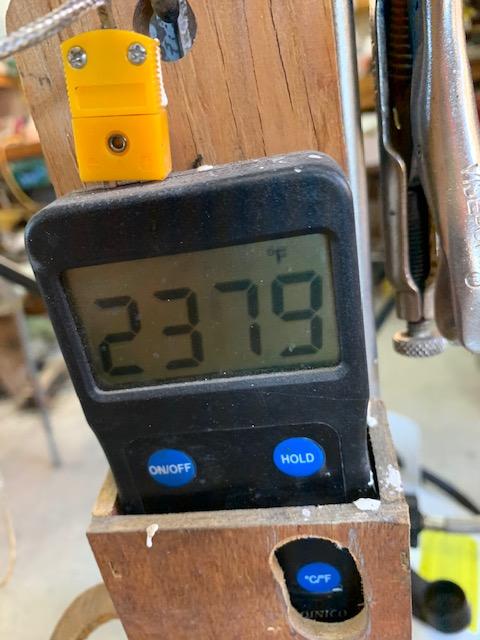-
Posts
335 -
Joined
-
Last visited
Content Type
Profiles
Forums
Articles
Gallery
Downloads
Events
Everything posted by D.Rotblatt
-

3D printed plastic burner experiments (photo heavy)
D.Rotblatt replied to Another FrankenBurner's topic in Gas Forges
I think that has gotten lost over time, at least for me. I'll put it in the variable toolbox! (toolbox of variables?...sigh...I'll just remember it.) Well said! It's being in a world of our own making; no disturbances, just figuring out where we want to go, and how to get there. It is complete control over ourselves and our environment...except when I can't find what I just put down.... DanR- 863 replies
-

3D printed plastic burner experiments (photo heavy)
D.Rotblatt replied to Another FrankenBurner's topic in Gas Forges
Its true, too many variables. It's a pretty forgiving burner, but I may have just gotten lucky on the first try. I was just blown away that moving the burner tube 2" increased the temp 100F...Now I'm just thinking, "What if I just...." I'm just chasin' that rabbit down his hole, I do need to actually use the darn things and make a few knives! ...or a sword...or a seax.....hmmmmm..... DanR- 863 replies
-

3D printed plastic burner experiments (photo heavy)
D.Rotblatt replied to Another FrankenBurner's topic in Gas Forges
Thanks! It's pretty much as cast with about 15 minutes cleanup - cast really clean. I was pleased! I don't know if the pressure in the plenum is comparable to venturi theory. The gas is flowing into a box rather then a larger tube, so you have weird turbulence issues, a right angle turn, back pressure from the number of outgoing holes...so many variables. I played today and did notice that the flame is leaning out a bit as I pull out the burner tube/lengthen the nozzle. Also sounds like it's pulling more air. The pitch of the air flow also changes, but that's just like pulling the tube on a trumpet. It may be more sensitive to nozzle length being that it's flowing into a box rather then into the open air or a forge. Either way, it works. No way to play with it more without cutting up my NARB, and thats now my go-to burner, so I may have to make a new one that has a larger opening on it that can take different sized tubes. DanR- 863 replies
-

3D printed plastic burner experiments (photo heavy)
D.Rotblatt replied to Another FrankenBurner's topic in Gas Forges
I agree, and as usual you are right: precise nomenclature is very important. I think what I should have said is: "Basically what you are saying is that the principle behind what's going on is parallel to that in a wasp waisted venturi?" This would have been clarified in moments if we were actually talking to each other in like....the real world! The internet is a great clearing house for ideas and confusion DanR- 863 replies
-
I did the same with wrought iron many years ago. It worked; both introduced enough carbon to be able to harden the wrought iron and gave a nice layered pattern when etched. Beyond creating a possible pattern, what do you hope to gain? 1095 is a great steel. DanR
-

3D printed plastic burner experiments (photo heavy)
D.Rotblatt replied to Another FrankenBurner's topic in Gas Forges
I was kind of thinking of the reducer as the decrease in diameter, and the flare as the increase in diameter...it just has a long straight tube in-between. So no, not a wasp waist, but the same principle? The furthest the burner goes in is pretty much the depth of the flare, so I was going from no flare to a couple inches of flare. I like you solution to no pyro. The pyro has it's issues as well - placement in the forge is the main one. When working where temps are critical (like heat treating) I use the color of the pyro as a known temperature to gauge the ballpark of where the metal is. It's always different. DanR- 863 replies
-

3D printed plastic burner experiments (photo heavy)
D.Rotblatt replied to Another FrankenBurner's topic in Gas Forges
That sounds reasonable. Yes, it's a step nozzle (3/4" black pipe into 1" schedule 40 pipe). Basically what you are saying is it acts as a wasp waist? Increase in diameter is lessening pressure thus draws more air. Though I thought the burner was running from lean to rich (it has a choke), this may have allowed it to go richer at it's "sweet spot" increasing flame temp. I'll take a look when I get to play with it. Thanks for the input Frosty! I got it, thanks! Basically, since it's out of our range to measure forge temps, the best we can do is surmise changes in flame temps from the forge temp by keeping other variables constant. In my case, the burner has a choke, so the constant was the gas pressure/jet size, while I was changing mixture via choke to get hottest forge temp. Then I moved the burner out (adding another variable) and pow - temps skyrocketed. In the 60's a psychological scientist working with rats in mazes discovered that the rats where following their own scents to get through the maze...thus invalidating decades of psychological research preceding him (or her). By changing the flare length on the burner, I just realized I've invalidated all my burner tests up to this point.... I really didn't pay any attention to how deep the burner was into the flare. DanR- 863 replies
-
Shows you how observant I was I knew what you meant and just went with it. I guess I just listened to what you meant, not what you said - I often screw up verbally (thank god for word processors). DanR
-

3D printed plastic burner experiments (photo heavy)
D.Rotblatt replied to Another FrankenBurner's topic in Gas Forges
Not odd that something happened, odd that it was so extreme and curious as to what is happening. It was a +100F temp change from forging heat to welding heat which is equivalent to cranking the gas up several pounds (at least 50% more) on my other burners. Why? Longer mixing tube = better mixing? Increase in size at nozzle = slowing of gas which does...what? Imitates a wasp waist? Allows it‘s right angle entry in the plenum to be easier? The end of the nozzle is welded to the plenum, so it’s not about FAM at the nozzle, it just changes the speed the gas entering the plenum. On the plus side, it’s a new variable in the NARB we’ll be able to control that could give better results! note: the black pipe extends into the bronze burner head about 3/4” DanR- 863 replies
-

3D printed plastic burner experiments (photo heavy)
D.Rotblatt replied to Another FrankenBurner's topic in Gas Forges
You're right of course, we don't know what's going on. I'm just making an observation. It was adjusted for maximum forge temperature with the burner pushed in all the way (which is just about the full length of the 1" sleeve), so it was at the hottest flame mixture I could get. Then I pulled it back 1.5" or so and the temp skyrocketed up 50F in just a minute or so and stabilized after several minutes at around 100F over the original temp...no adjustment of pressure or mix, just moved the burner out. Haven't played with it, so don't know what is going on, but it's getting the gears moving. Also quick question...How would I measure the burner flame temps without burning up my pyrometer? Have to do it inside the forge or the environment adds another variable. Basically, what method would you suggest to best measure the burner flame temps? DanR- 863 replies
-

3D printed plastic burner experiments (photo heavy)
D.Rotblatt replied to Another FrankenBurner's topic in Gas Forges
LOL. Rubber cyber chicken party???? Sounds fun, I’ll bring the virtual beer! Thanks for the compliment, that’s the wonder of 3D printing, 30 minutes extra playing around and it looks professional! I did put ‘Old Canyon Forge’ on it. Oddly it burns 100F hotter pulled back in the 1” tube a bit. Like having a nozzle helps pull more air or mix it better even though the nozzle is welded to the plenum. I need to play around with that, but something significant is going on there. DanR- 863 replies
-
Success! Replugged the center holes, leaving 8 rows (4 on either side) of 24@. So 192 holes total. Basically it's like having two side by side long burners. Not much hassle getting it to heat. Needed to run it at 15lbs and a little rich until it got up to 2000F, then it was fine. No singing anymore! Ran it a few hours and worked on a wrought iron viking axe I'm making for a friends wedding. It's a forced air, running with two .040 jets (so it's consumption at various pressures is equivalent to two 3/4" burners). Forge is about 320-350 cu inches (about 4.5 x 5 x 14" long). Once up to heat (takes a little time since it has a Mizzou refractory shelf), I was running it at about 3 lbs a little rich and it was holding at 2300 or so for regular forging (I was forging wrought so I was going hot). If I brought it up to 5-6 lbs, it was going over my 2400F max on my digital pyrometer. Seems really really efficient! Also seems like it may still be a little overpowered for the forge. I'll take some pics when I play today. Also, got a movie of the flames singing. We'll see if it downloads...Nope. Didn't. I'll have to figure it out. You can see the flames vibrating when it sings...very cool to see the harmonics. DanR
-

3D printed plastic burner experiments (photo heavy)
D.Rotblatt replied to Another FrankenBurner's topic in Gas Forges
Latest cast burner. Works great. Played with a few tips and ended up with a 3D printer tip drilled to .046. Don't need to show the forge running....it's hot. 2380F at 5 lbs. DanR- 863 replies
-
I'll put it on the list!
-
Good thoughts! I used something similar years ago for a furnace nozzle. It worked great, and is a good idea for molding a burner head. easy to put in place and punch holes in before dry, works like clay as I remember. It's a high temp refractory as I recall. But I don't have any now, and want to use what I have, especially for such a small amount - I have all sorts of refractories and clays to play with and plug some holes. Just takes time... DanR
-
My normal ribbon burner (with 1/4" holes) makes some sound at first sometimes, but slight mixture adjustments stop it. It does take my larger blower to get to welding heat, the little Dayton 50 CFM blower is fine for forging but not for welding. A stronger blower will probably work. You're 1/4" plate is also much thinner then cast faces, so I don't know what effect that will have. It will also heat up and may backfire if it gets too hot - hopefully not. You'll have to see. DanR
-
Agreed. I did put a larger blower on it, and it worked. Still made an organ sound at the right mixes when not hot, but at the same time the flame was blown 1-2" of the head - so it wasn't backfiring, just resonance. The flame was so strong I was running at 30 lbs (two .040 holes), it was lean, and the heat shooting out the door kept me several feet away. There's a different sound that's lower and the flames disappear, that's the back-firing - the flame burning back into the holes. Then there's the infamous "POP" - which is a backfire. This burner has now seen them all! Yup, I concur! Maybe zircon soaked ceramic fiber pushed deep into the holes will do it. It should form a solid plug. I'll play and see...it'll either work or it won't. Either way we'll get more data! Thanks for the thoughts! DanR
-
Yup, I figured that was the case. Masonry bits are carbon tipped and cheap, plus the tip is larger then the shank so debris will not get caught up as easy. I've used a piece of welding rod for a drill before too Use what ya got! I was thinking about casting or drilling a new burner head, being that the seal cracked on it and it's got "troubles". But that's a lot of work. So now I'm rethinking about taking the time to fill those holes up deeper. Maybe a mix of zircon/bentonite clay would work better and fill the hole deeper. I played with making a few mixes and they are strong and stable under heat and smooth enough so they can probably be pushed pretty far into the holes. I'll get this thing to work if it kills me! DanR
-
For an IFB probably a carbide tipped masonry bit. An IFB is so soft it’s just about clearing the debris from the hole so it doesn’t break out the brick. I’d do a peck drill routine. Could also just use an old carbide end mill. Dan
-
After sleeping on it, I had one other thought on the back firing. I put a thin coat of mortar over the holes to seal them. In the hole behind the mortar is gas/air mix...maybe when the mortar on the holes is hot enough it’s igniting the gas in the plenum and “POP”! Dan
-
Okay....new wrinkle; back-firing (not back burning). So I blocked off all but 8 rows of holes with mortar (that left 192 holes open). I had to do a little bit of adjusting while it got up to heat, but it meant startup would be a tweak and walk away for a few minutes and tweak again kind of thing. So I get it going and I adjust the pressure to 10 lbs or so, and the damper to about 3/4. Took about 10 minutes to heat up. So it's nice and hot, up in the 2250F range running even and beautiful. So I walk away to let it run and see where the temperature will settle and suddenly "POP" big back-fire. Wasn't looking at it, so I wait a minute or two and "POP" it does it again. So I shut it off, and that's where I stand. I did have one problem before this that might effect things, the burner cracked around the seam between the cast head and the metal shell when I cut it open and pulled out the baffle. All the vibrations of cutting cracked the seal I think. I sealed it back up with my zircon/colloidal silica mix and some mortar. Didn't see any leak when I started it up, but wasn't looking too hard so maybe there was in the back and it heated the shell. Honestly, I was just so freaked out by the backfire that I forgot to check if the shell was hot. I'm not giving up, but I am stumped right now, except to check if there is a leak in the shell/face. Hate to have to start over.... _______ True. Taking a quick google trip: this blower puts out 18 cfm at .5" sp. .5 inches static pressure = .0181 psi. So if I figured that right (which is no certainty), that's not going to make much difference from a high pressure propane jet. I'm game. What it looks like is the flames go from a normal non-moving cone when not singing, to seeming to vibrate in unison side to side at an incredibly fast rate. There are times when it will sing, stop, sing, stop, etc, so it's easy to watch them. Quite mesmerizing. It could be jumping off the end of the burner then reigniting from the flames next to them, or....????? Either way, the hot face seems to stabilize them. Yup! I thought when I got my NARB mod to work so easily the first time, that this would go easily too. But it's not looking like that. This back-firing is really bothering me. I thought I had it worked out too Thanks! Glad it's helpful. I'm interested in the drilled brick faces. I assume you are using IFB's. Seems an easy way to make them. I have a pile of IFB bricks, but they just don't hold up in the forge. They always crack. I know Frosty and Mikey recommend a particular brand and I may get some of those. I have a CNC mill, so it's easy to set up and drill stuff. Love to see how your's work in the forge! It's a different animal. I did test mine using Frosty's method of drilling a board as a face. You get around 30 seconds before it starts to burn, but you can see if it will work. That's how I came to around 125 holes as working best for my NARB. DanR
-
Some success: First: I put replaced the dayton with a larger blower. Put up the psi to 30lbs and opened her up at full throttle. As I turned up the needle valve it ignited, running lean as starving marathon runner. No dragons breath, but a blast of hot air that was hair singeing from 4 feet from the door. No singing until I started to close the gate a bit. Turns out there's a range somewhere near neutral that it did sing, but not backfire. Just a sound like blowing across a bottle...but lots of bottles at the same pitch. Flame was way off the burner head. Upshot is that more back pressure prevented backburn (as expected). Second: I ran a piece of tape across the middle 6 rows of holes (lengthwise, each row is 24, so I had 192 holes open) and covered the tape with refractory mortar. I hooked up the the dayton blower. Same thing, sang around neutral but didn't really back-burn and ran at lower temperatures. It only worked for 30 seconds or so and the mortar warped and exposed/opened the middle rows of holes. Then, since it was moving in the right direction, I plugged 4 rows of holes with the mortar and gave it a try. But at 240 holes open, it's still too much. A bit of improvement though. It seems 336 holes is way too much. Probably half that, 175 plus or minus should work. I'll plug a row at a time (24 holes) and see what the results are this weekend. DanR Frosty: Might be a miscommunication on my part here. I was running a very rich flame to keep it from backfiring because every time I adjusted it to neutral or lean when it was cool it sang and backfired. Once it heated up, I was able to reduce the propane pressure to get a neutral flame.
-
Thanks for chiming in Frosty and Buzzkill! The damper is a plate that slides over the intake in the fan. I also have a gate just after the fan and before the propane jet. I agree. When it happens I can see the flames vibrating in unison. I think its starting to burn back, extinguishing and/or reigniting in again (perhaps by the flames next to it). There is a pattern though - clean burn with a rich flame, then as I lean out the flame (but still rich) it sings in a high pitch, then as I lean it out more it back-burns. I'm using a little dayton blower, 1TDN7, about 50 cfm free flow. Definitely not enough to inhibit the delivery of propane. The only thing I can think of is that it is igniting the FA mix at the exit of the nozzles and preventing it from burning back in. If that's the case, I simply have insufficient pressure in the plenum (which gets to Buzzkills thoughts). I made the jets the size of 3/4" burners because I wanted to compare consumption. I figured I could just crank it up to what I needed. You are right, the pressure is purely provided by the air source. The 2 jets are able to provide plenty of propane, with the blower wide open I can run a very rich flame. The plenum is significantly larger then my other two ribbon burners, but I don't think its the size of the plenum, rather the size of the openings that would reduce pressure. Either way it has nearly 3 times more holes then my little NARB with 1/8" holes which is powered by a single 3/4" burner. But this is a FARB, so I figured the blower would keep it pressurized enough. The mixing tubes are much larger; 3" or over I think. The idea was to provide less restriction for air flow. I pulled this blower assembly off my regular Wayne Coe style ribbon burner, and it worked fine on that (though I have changed the jet size, but I should be able to just run it at higher pressure). It is possible that the burner is just way oversized for the forge and blower, and I'm trying to run it at pressures that are too low. I just did a quick calculation: I'll have to check to be sure, but if I remember right about the number of holes in my old Wayne Coe burner, the area of the holes in this new ribbon burner I made are about 3x the area of opening. about 6" area for the old one, and 17" area for this new one. I think I'll have to block off about 2/3 of the holes and see what happens. The thickness and construction of the block is identical to the NARB, only width, length and number of holes are different. I'll also first try putting on a blower I have that is more powerful running full open and see if that makes a difference. OK! Thanks both of you! I have a direction and a working theory. Side note to Frosty: the last layer of refractory I put on (which would be the face inside the plenum) was sifted Mizzou with no aggregate in it. It is powdery and has no strength, just turns to powder if scratched. The rest of the head, where I put aggregate (even if it was crushed and small), has plenty of strength so far. DanR
-
OK guys 'n gals...HELP! This ribbon burner works once up to heat, but takes a lot of attention and time to get up to heat and running properly - and that's a fail for me, since I don't want to sit around for 20+ minutes slowly futzing with it to get it going. If I wanted to do that I'd use a D*#@m coal forge. I'm getting good heats: 2325 @ 7 lbs, and 2200 at 3 lbs (the jet is two #60 or .040" holes, so that's like a 2 burner forge in gas consumption) Problem/question: it takes 20+ minutes of focused care to bring it up to heat. Unless it's running very rich, it backfires. So to get it up to heat I have to run it at high pressure (15-20 lbs propane) with the damper closed down to make it rich. It stalls around 1600-1700, then I move the damper a hair (literally), wait as temp goes up a little, repeat until it's up over 2000, then I can slowly turn up the air and turn down the propane to around 7 lbs or so. My take is that once the face is hot enough, the propane ignites on it before it can burn back into the tubes. The backfiring takes on two types: one is a higher pitched organ sound where I can see the flames vibrating. The other is a sudden drop to a lower pitch (maybe an octave down) and the flames disappear and the plenum will start to get hot. I have tried: -I tried blocking 3 rows of holes down the middle. That blocked 72 holes; which reduces the # of holes by almost 1/5, but no difference. -opening the door thinking that it's back pressure that's causing the backfiring: slight improvement but very little. -I had put a damper in and noticed that the face of the burner under the damper was much hotter then the rest in a pattern that matched the area that would be blocked, so I cut it open and removed the damper and welded it shut again in order to even the temperature up. No love, little difference, maybe a little worse. -I've tries all different combinations of pressure and gas mixture: backfires at low pressures, and when neutral to lean at any pressure until it is hot enough. Thoughts Only thought I have, since it works well (though blows out at higher pressures) outside the forge, is that there is too much backpressure. The inside is very small for a forge, only 4.5" wide x 4.5" high by 14" deep. I'd hate to have to pull it apart and go with one layer of ceramic fiber, but that may be the next thing I try to do. I will try taking the Mizzou shelf off with will add nougat 1/2-3/4" of depth. That will add another 30 cu inches...but I doubt it will make much difference. Any thoughts will help, thanks in advance! DanR
-

3D printed plastic burner experiments (photo heavy)
D.Rotblatt replied to Another FrankenBurner's topic in Gas Forges
Yes, the actual diameter of the holes. But the Reil is a hole in the side of a tube, while my cast burner is a mig tip, and the tips are drilled out. Actually I think it's a .042 now that I think about it. Dan- 863 replies

